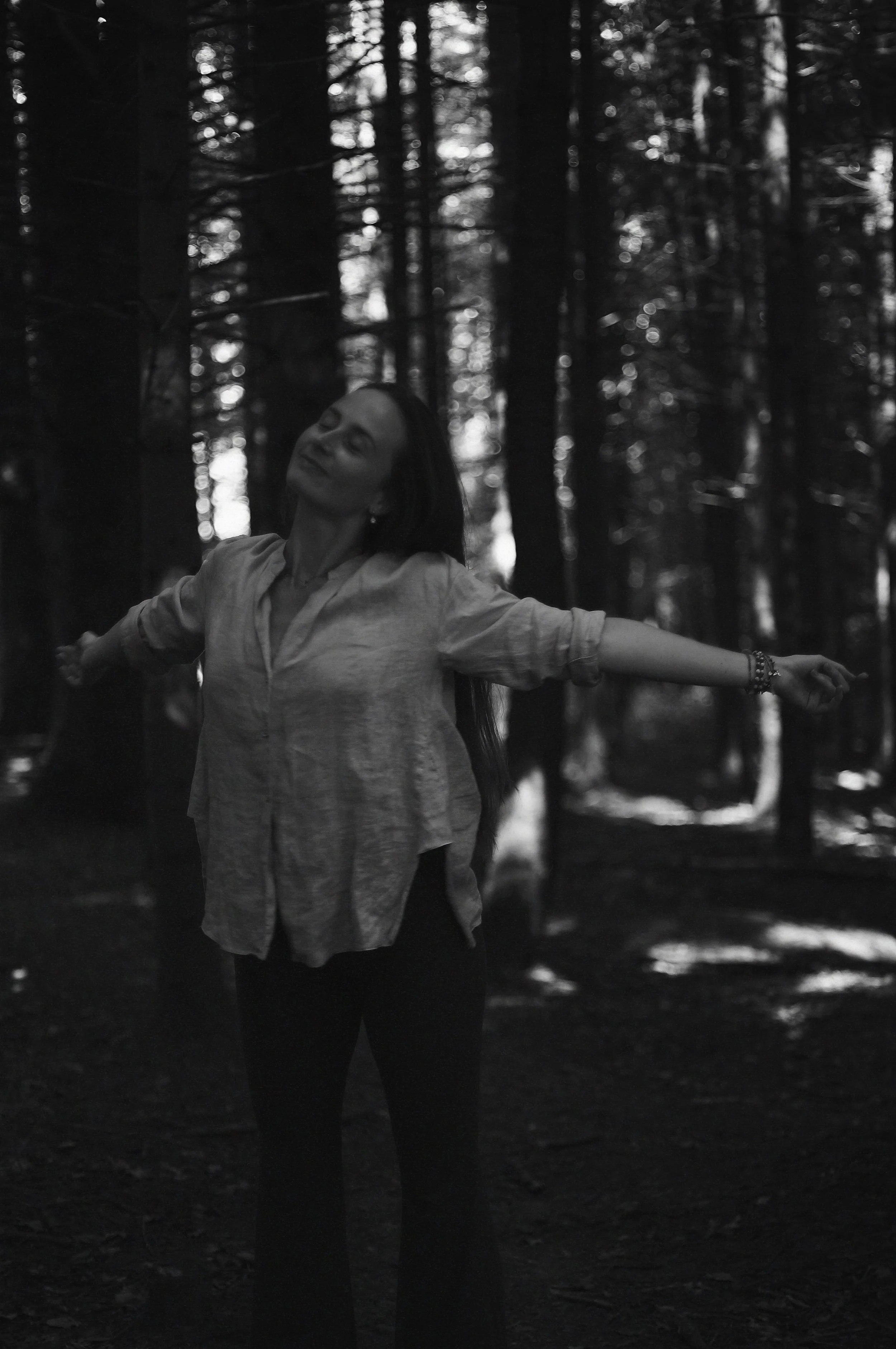
Self-Practice Toolbox
Take Charge of Your Practice
Practicing at home can feel hard sometimes — knowing where to start, what to do, or how to stay consistent when motivation dips. We’ve all been there.
This toolbox was created to make self-practice feel simpler and more intuitive. Instead of following a fixed routine, you’ll learn to listen inward and begin exactly with how you feel in this moment.
Each section offers a step-by-step approach to help you find what you need right now:
to ground when life feels scattered,
to energize when you feel low,
or to restore when you need softness and rest.
Whether you have five minutes or a full hour, these small rituals of movement, breath, and stillness are here to guide you back into connection with your body, your breath, and your rhythm.
How to Use the Toolbox
Take a moment to arrive. Close your eyes and notice your breath. Give yourself a moment invite presence.
Ask yourself: How do I feel right now? Physically, emotionally and energetically. Be honest with yourself.
Choose the category that matches your current state — Ground, Energize, or Restore.
Pick one movement, one breath, and/or one short meditation from that section. I recommend doing the movement practice before the breath and the meditation practice because it prepares the body to sit in silence.
Practice for 5–30 minutes, letting it be simple and personal. Start with 5 minutes and you’ll notice if you want to continue and do more or if that’s enough. Don’t overcommit! If you schedule 1 hour of movement and breath plus 15 minutes of meditation everyday you’re setting yourself up for disappointment. 5 minutes everyday is better than nothing and oftentimes you will want to do more than that. And if not, you will have still done something.
You can use the guided movement flows as well as the guided meditation on a daily basis. If you’re at the very start of your practice you will benefit most from following a guided class. Start observing how your body, breath and mind react to the classes and notice what feels good and what doesn’t. This is how you reconnect with your intuition. Modify according to your needs — once you learn to recognize them!
Move & Breathe
Ground
For moments when you feel unsteady, anxious, or disconnected.
— Move —
Focus on lower body activation
Warm up toe to head in a stand
Pick 1-3 posture(s) per category
Hold each posture for 5 breaths
End with at least 1min of Savasana
Warm Up (standing): Calf Raises, Hip Rotations, Spinal Waves, Neck Rotations, Shoulder Rotations, Side Bending, Eagle
Standing Postures: High Lunge, Goddess, Mountain, Warrior II, Chair, Forward Fold
Standing Balancing Postures: Warrior III, Stork, Extended Hand to Big Toe, Standing Split, Sugarcane, Half Moon
Hip Opening Postures: Yogi Squat, Bound Angle, Side Lunge, Pigeon, Fire Log, Low Lunge, Half Split, Frog or Half Frog
— Breathe —
Observe the breath as it is
Expand inhales, lengthening exhales
Choose 1 grounding breath practice and do it for 5min:
Equal Breath: inhale 5, exhale 5 (you can increase the count with time)
Box Breath (4-4-4-4): inhale 4, hold 4, exhale 4, hold 4
Out-Breath Hold: 3 breath cycles, hold breath after 3rd exhale for 15sec
Energize
For low energy, sluggish mornings, or when you need a spark of motivation.
— Move —
Focus on dynamic movement
Pick 3-5 twisting postures (you can add other postures in between)
Hold each posture for 3-5 breaths or move dynamically from one movement to the other with 1 breath per movement
Optional: 1-2 Back Strengthening Posture(s)
Warm Up: Cat Cows, Bird Dog, Hip Rotations in Table Top, Down Dog to Plank, Yogic Squat to Forward Fold
Sun Salutations: 1 breath per movement
Twisting Postures: Twisted Chair, Twisted Lunge, Revolved Triangle, Thread the Needle, Supine Twist
Back Strengthening Postures: Cobra, Locust, Puppy Pose, Sphinx, Shoulder Bridge, Crescent Lunge
— Breathe —
Observe the breath as it is
Create deeper inhales, expand the lungs
Choose 1-2 energizing breath practices:
Quick Inhales: inhale 3, exhale through the mouth (1min)
Lung Packing: inhale 5, hold 10, sip in more air, hold 10, exhale 5
Double the Inhale: inhale 10, exhale 5 (3 min)
Restore
For times of fatigue, tension, or emotional overwhelm.
— Move —
Focus on longer holds and gentle sensations
Stay low to the ground
Pick 3-5 postures in total
Hold each posture for 5-10 breaths
Give yourself 5min of Savasana
Seated Postures: Seated Cat Cow, Side Bend, Sufi Rolls, Forward Fold (crossed legs or extended), Shin Box Switch
Supine Postures: Legs-Up-the-Wall, Supine Bound Angle, Supine Twist, Figure 4, Single Leg Hamstring Stretch, Wind Relieving Pose
Supported Savasana: Use bolsters, blocks, blankets and/or eye covers to make your final resting position as cozy as possible
— Breathe —
Observe the breath as it is
Slow inhales, complete exhales
Choose 1 calming breath practice and do it for 5-10min:
Three Part Breath: inhale belly-chest-throat, exhale throat-chest-belly
Humming Breath: inhale gently, exhale all the air out in a humming sound
Extended Exhale: inhale 5, exhale 10

Meditate
Meditation is one of the simplest ways to reconnect with yourself, yet it’s often the hardest to begin. When we sit in stillness, we create space to observe — our thoughts, our sensations, our reactions — and over time, that awareness changes how we move through life. We become less reactive, more grounded, and more able to respond with clarity rather than impulse.
Here are a few simple steps to help you start:
Let go of the goal.
Meditation is NOT about getting rid of thoughts. It’s about noticing them without being pulled in. Each time you observe rather than react, you strengthen your ability to step out of automatic patterns and meet life with more presence.Sit with what arises.
Stillness can feel uncomfortable at first. Restlessness, emotions, or boredom may surface — and that’s okay. The practice is to stay, to breathe, and to witness what comes up with compassion.Keep it short and consistent.
Start with just five minutes. Set a timer, close your eyes, and focus on your breath. Over time, you can stay longer — but even five mindful minutes a day make a difference.Find your seat.
Sit on a cushion or yoga block so your hips are slightly higher than your knees. Keep your spine long, your belly and chest open, your shoulders soft. Comfort supports focus.Optional: Journal after.
When you finish, write down what you noticed — sensations, emotions, or thoughts that stood out. This helps you process and observe your inner patterns over time.
Guided Meditation
Here’s a guided 10 minutes meditation that you can do daily. If you’re just starting out, this will help you guide your awareness without getting too distracted. Once you become used to being guided in meditation try sitting in silence and see how that goes.
Keep It Simple
You don’t always need a mat, a long playlist, or the perfect setting.
Five minutes of mindful movement, a few conscious breaths, or a quiet pause is already enough to shift your physical and emotional state and to help you be more present.
Let this be your gentle reminder that practice doesn’t need to be perfect — it just needs to be yours.
You got this.


